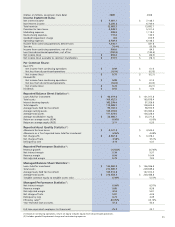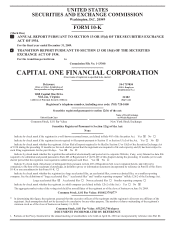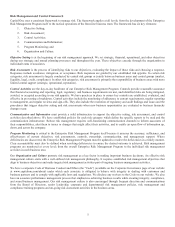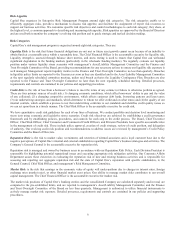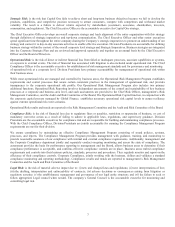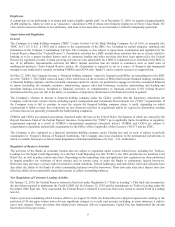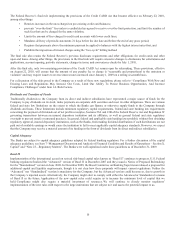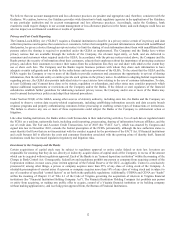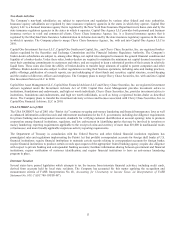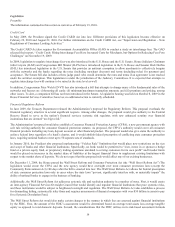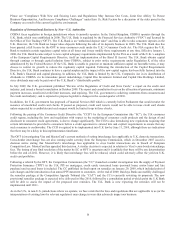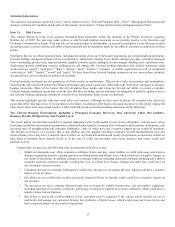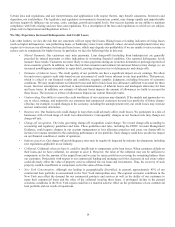Capital One 2009 Annual Report Download - page 22
Download and view the complete annual report
Please find page 22 of the 2009 Capital One annual report below. You can navigate through the pages in the report by either clicking on the pages listed below, or by using the keyword search tool below to find specific information within the annual report. 9
Employees
A central part of our philosophy is to attract and retain a highly capable staff. As of December 31, 2009, we employed approximately
28,000 employees, whom we refer to as “associates,” and almost 2,900 of whom were formerly employees of Chevy Chase Bank. We
view current associate relations to be satisfactory, and none of our associates is covered under a collective bargaining agreement.
Supervision and Regulation
General
The Company is a bank holding company (“BHC”) under Section 3 of the Bank Holding Company Act of 1956, as amended (the
“BHC Act”) (12 U.S.C. § 1842) and is subject to the requirements of the BHC Act, including its capital adequacy standards and
limitations on the Company’s nonbanking activities. The Company is also subject to supervision, examination and regulation by the
Federal Reserve Board (the “Federal Reserve”). Permissible activities for a BHC include those activities that are so closely related to
banking as to be a proper incident thereto such as consumer lending and other activities that have been approved by the Federal
Reserve by regulation or order. Certain servicing activities are also permissible for a BHC if conducted for or on behalf of the BHC or
any of its affiliates. Impermissible activities for BHCs include activities that are related to commerce such as retail sales of
nonfinancial products. Under Federal Reserve policy, the Corporation is expected to act as a source of financial and managerial
strength to any banks that it controls, including COBNA and CONA (the “Banks”), and to commit resources to support them.
On May 27, 2005, the Company became a “financial holding company” under the Gramm-Leach-Bliley Act amendments to the BHC
Act (the “GLBA”). The GLBA removed many of the restrictions on the activities of BHCs that become financial holding companies.
A financial holding company, and the non-bank companies under its control, are permitted to engage in activities considered financial
in nature (including, for example, insurance underwriting, agency sales and brokerage, securities underwriting and dealing and
merchant banking activities); incidental to financial activities; or complementary to financial activities if the Federal Reserve
determines that they pose no risk to the safety or soundness of depository institutions or the financial system in general.
The Company’s election to become a financial holding company under the GLBA certifies that the depository institutions the
Company controls meet certain criteria, including capital, management and Community Reinvestment Act (“CRA”) requirements. If
the Company were to fail to continue to meet the criteria for financial holding company status, it could, depending on which
requirements it failed to meet, face restrictions on new financial activities or acquisitions and/or be required to discontinue existing
activities that are not generally permissible for bank holding companies.
COBNA and CONA are national associations chartered under the laws of the United States, the deposits of which are insured by the
Deposit Insurance Fund of the Federal Deposit Insurance Corporation (the “FDIC”) up to applicable limits. In addition to regulatory
requirements imposed as a result of COBNA’s international operations (discussed below), COBNA and CONA are subject to
comprehensive regulation and periodic examination by the Office of the Comptroller of the Currency (“OCC”) and the FDIC.
The Company is also registered as a financial institution holding company under Virginia law and, as such, is subject to periodic
examination by Virginia’s Bureau of Financial Institutions. The Company also faces regulation in the international jurisdictions in
which it conducts business (see below under Regulation of International Business by Non – U.S. Authorities).
Regulation of Business Activities
The activities of the Banks as consumer lenders also are subject to regulation under various federal laws, including the Truth-in-
Lending Act, the Equal Credit Opportunity Act, the Fair Credit Reporting Act (the “FCRA”), the CRA and the Service members Civil
Relief Act, as well as under various state laws. Depending on the underlying issue and applicable law, regulators are often authorized
to impose penalties for violations of these statutes and, in certain cases, to order the Banks to compensate injured borrowers.
Borrowers may also have a private right of action for certain violations. Federal bankruptcy and state debtor relief and collection laws
also affect the ability of the Banks to collect outstanding balances owed by borrowers. These laws plus state sales finance laws also
affect the ability of our automobile financing business to collect outstanding balances.
New Regulations of Consumer Lending Activities
On January 12, 2010, the Federal Reserve released a final rule under Regulation Z (“Truth in Lending”). This final rule incorporates
the provisions required to implement the Credit CARD Act by February 22, 2010 and the amendments to Truth in Lending under the
December 2008 final rule. Now superseded, the Federal Reserve retracted its previous final rules issued to amend Truth in Lending
and AA.
Under a previous rulemaking which became effective on August 20, 2009, the Federal Reserve adopted requirements relating to the
provision of 45-day prior written notice for any significant changes to a credit card account, including, in some instances, a right to
reject such changes. These provisions also adopted new statement delivery requirements. Capital One has implemented the interim
final rules for these provisions.


